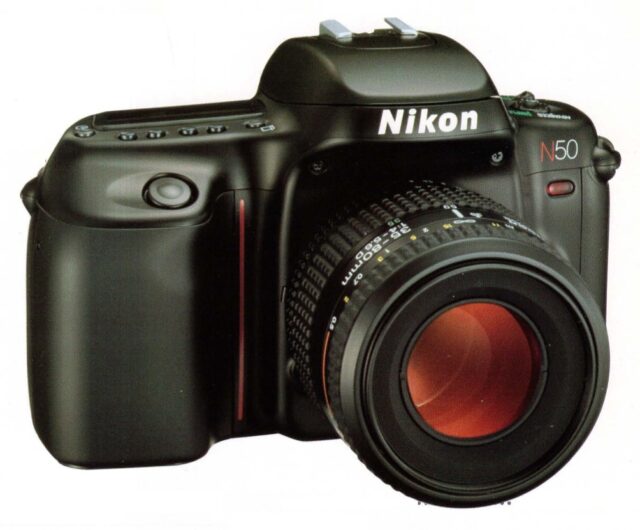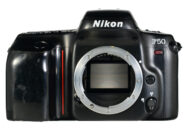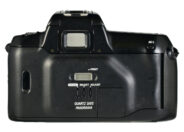Announced
Production status
System
Nikon F system cameras
- Nikkorex F
- Nikkormat EL
- Nikkormat ELW
- Nikkormat FS
- Nikkormat FT
- Nikkormat FT2
- Nikkormat FT3
- Nikkormat FTN
- Nikon D3
- Nikon D3s
- Nikon D3X
- Nikon D4
- Nikon D4s
- Nikon D5
- Nikon D6
- Nikon D600
- Nikon D610
- Nikon D700
- Nikon D750
- Nikon D780
- Nikon D800
- Nikon D800E
- Nikon D810
- Nikon D850
- Nikon Df
- Nikon EL2
- Nikon EM
- Nikon F
- Nikon F100
- Nikon F2
- Nikon F3
- Nikon F4
- Nikon F5
- Nikon F6
- Nikon FA
- Nikon FE
- Nikon FE10
- Nikon FE2
- Nikon FG
- Nikon FG-20
- Nikon FM
- Nikon FM10
- Nikon FM2
- Nikon FM2/T
- Nikon FM3A
- Nikon N2000
- Nikon N2020
- Nikon N4004
- Nikon N4004S
- Nikon N50
- Nikon N5005
- Nikon N55
- Nikon N60
- Nikon N6000
- Nikon N6006
- Nikon N65
- Nikon N70
- Nikon N75
- Nikon N80
- Nikon N8008
- Nikon N8008S
- Nikon N90
- Nikon N90S
Nikon N50
aka Nikon F50
35mm AF film SLR camera • Discontinued
Specification
| Format: | |
| 35mm full frame | |
Film type: | 135 cartridge-loaded film |
| Nikon F [46.5mm] | |
| Shutter: | |
Type: | Focal-plane |
Model: | Electronically controlled |
Speeds: | 30 - 1/2000 + B |
| Exposure: | |
Exposure metering: | Through-the-lens (TTL), open-aperture |
Exposure modes: | Programmed Auto |
| Aperture-priority Auto | |
| Shutter-priority Auto | |
| Manual | |
| Physical characteristics: | |
Weight: | 580g |
Dimensions: | 149x96x70mm |
Manufacturer description #1
Now great Nikon photographs are as easy as pushing a button. Want a portrait? Push a button. Want a silhouette? Push a button. Want a close-up? Push a button. The N50's automatic operation can give you the kind of photos you'll be proud to show and hang on your wall. Matrix metering, built-in flash, interchangeable lenses and other advanced features make the N50 the perfect step up to Nikon 35mm SLR photography.
GET THE KIND OF PICTURES YOU'VE ALWAYS WANTED - QUICKLY AND EASILY
Nikon's new N50 delivers an array of great 35mm SLR photographs at just the touch of a button. It's the ideal "step-up" camera for photographers who might have been intimidated by 35mm SLR photography.
SIMPLE MODE
With the camera set on the "simple" mode, just press a button to create the kind of Nikon photograph you want. While you compose, the N50 automatically sets the exposure. Focus is automatic in light as low as EV minus 1.
SIMPLE MODE PROGRAMS:
GENERAL PURPOSE PROGRAM
This selection appears automatically when the camera is turned on. It's great for changing everyday pictures into beautiful photographs.
LANDSCAPE PROGRAM
Press the button for the Landscape icon. Achieves greater depth-of-field for postcard-perfect pictures. Outstanding with AF Nikkor wide-angle lenses.
PORTRAIT PROGRAM
Press the button for the Portrait icon and the depth-of-field becomes shallower; Now the background becomes softer, making subjects stand out. Ideal with AF Nikkor portrait-range lenses (85 to 135mm).
CLOSE-UP PROGRAM
Again the subject stands out from the background. Especially effective with AF Micro-Nikkor lenses and AF Nikkor zoom lenses with macro focus.
ADVANCED MODE
With the camera set to the "advanced" mode, you can create even more types of photographs.
ADVANCED MODE PROGRAMS:
SPORT PROGRAM
Uses higher shutter speeds and creates a feeling of slight motion in your pictures. Add an extra dimension to your photos by panning with a moving subject. Effective with nearly every AF Nikkor lens.
SILHOUETTE PROGRAM
Imagine - automatic silhouettes! Subjects appear dark against a bright background. Outstanding near windows, at sunset or other strongly backlit situations.
NIGHT SCENE PROGRAM
Captures background lights. For dramatic photographs, add flash for automatically beautiful nighttime flash photography.
MOTION EFFECT
This selection automatically chooses slower shutter speeds to make subjects appear to flow through the scene. Also creates a great effect with panning.
ADVANCED FEATURES OF THE N50
SHARP, CLEAR INFORMATION READOUT
The N50 is the first SLR camera to use a dot-matrix LCD panel. It's not only easy to see in any light, it's also easy to understand!
6 SEGMENT 3D MATRIX METERING
The N50 uses a 6-segment matrix light-metering system to evaluate each scene. When used with Nikon's new D-type autofocus lenses, it combines exposure information with data on distance and focus. The result? Reliable exposures, frame after frame, even in difficult lightning.
BUILT-IN FLASH
Powerful built-in flash pops up. Advanced matrix-balanced fIll-flash means all-new pictures. Use flash in daylight to brighten shadows, while keeping background light natural-looking.
LOW LIGHT AUTOFOCUS/FOCUS TRACKING
The N50's advanced AM200 autofocus sensor module works in light as low as that of one candle (EV minus 1). In light where you can hardly see, it can! And, Nikon's revolutionary focus tracking has also been incorporated into the N50.
INTERCHANGEABLE NIKKOR LENSES
Because the N50 incorporates Nikon's famous F lens mount, you can choose from a wide variety of AF Nikkor lenses. All are designed to take the world's greatest pictures.
OPTIONAL SPEEDLIGHTS
Use the N50's powerful built-in flash or choose an optional Nikon Speedlight like the compact SB-22, SB-23 or advanced SB-25. Either way, you'll gain power and versatility.
AN ARRAY OF ACCESSORIES
The N50 accepts a full range of Nikon system accessories, including camera cases, camera straps, eyepiece correction lenses and attachments for close-up photography.
OTHER ADVANCED FEATURES
Other advanced mode techniques include shutter-priority auto exposure, aperture priority, auto exposure and manual exposure. • Top shutter speed 1/2000 sec; top flash sync 1/125 sec. • Flexible Program enables you to shift an automatically selected shutter speed or aperture combination by 1 EV. • AE-lock lets you change picture composition without affecting exposure. • Exposure Compensation allows you to deliberately overexpose or underexpose photos by ±5EV in 1/2EV increments. • Exposure Memory stores your favorite exposure mode or program for instant recall. • Choice of Focus Modes lets you choose "Single Servo" autofocus for stationary subjects; "Continuous Servo" to stay with the action. Also focus manually. • Self Timer lets you become the subject of your own pictures. • Extra-long Time Exposure setting keeps the shutter open as long as you like.
Manufacturer description #2
TYPE OF CAMERA: Integral-motor autofocus 35mm single-lens reflex
PICTURE FORMAT: 24mm x 36mm (standard 35mm film format)
LENS MOUNT: Nikon F mount
LENSES: AF Nikkor lenses (except AF-Nikkor 80mm f/2.8, ED 200mm f/3.5 IF, and autofocus converter TC-16/TC-16A), and non-AF Nikkor lenses (with limitation) available
OPERATION mode: SIMPLE and ADVANCED
FOCUS MODES: Autofocus and manual
AUTOFOCUS MODE: Single Servo AF and Continuous Servo AF. Continuous Servo is possible in ADVANCED mode only
AUTOFOCUS DETECTION SYSTEM: TTL phase detection system using Nikon advanced AM200 autofocus module
AUTOFOCUS DETECTION RANGE Approx. EV -1 to EV 19 at ISO 100
AUTOFOCUS LOCK: Possible, in Single Servo AF mode, once a stationary subject is in focus as long as the shutter release button is lightly pressed
FOCUSING TRACKING: Automatically activated with a moving subject
EXPOSURE MODES: Programmed Auto in SIMPLE mode; Programmed Auto, Shutter-Priority Auto, Aperture-Priority Auto and Manual in ADVANCED mode
PROGRAM AUTO EXPOSURE CONTROL: Both shutter speed and aperture are set; in SIMPLE mode, General-Purpose Program, Landscape Program, Portrait Program and Close-Up Program are available; in ADVANCED mode, General-Purpose Program, Landscape Program, Portrait Program, Close-Up Program, Sport Program, Silhouette Program, Night-Scene Program, and Motion Effect Program are available
FLEXIBLE PROGRAM: Possible with General-Purpose Program in ADVANCED mode when flash is off
SHUTTER-PRIORITY AUTO EXPOSURE CONTROL: Aperture automatically selected to match manually set shutter speed
APERTURE-PRIORITY AUTO EXPOSURE CONTROL: Shutter speed automatically selected to match manually set aperture
MANUAL EXPOSURE CONTROL: Both aperture and shutter speed are set manually
SHUTTER SPEED / APERTURE ADJUSTMENT: Pressing the adjust button changes shutter speed or aperture in 1/2 step; holding down the adjust button rapidly changes shutter speed or aperture in one step
AUTO EXPOSURE LOCK: Available by pressing the AE-L button while the exposure meter is on
EXPOSURE COMPENSATION: Possible in ADVANCED mode within ±5 EV range in 1/2 steps
EXPOSURE METERING: Matrix Metering (for Programmed Auto, Shutter-Priority Auto, and Aperture-Priority Auto exposure modes); Centre-Weighted Metering for Manual exposure mode
EXPOSURE METERING RANGE: EV 1 to EV 20 at ISO 100 with f/1.4 lens
EXPOSURE METER SWITCH: Activated by lightly pressing shutter release button; when the LCD panel shows the Exposure Mode menu, Program menu, Optional - Function menu, or Optional Function settings, stays on for approx. 60 sec.; when the LCD panel shows the Program/exposure mode, stays on for approx. 8 sec. with the built-in flash off or 15 sec. with the built-in flash on
SHUTTER: Electronically controlled vertical-travel focal-plane shutter
SHUTTER RELEASE: Electromagnetic
SHUTTER SPEEDS: 1/2000 sec. to 30 sec.; electromagnetically controlled Time setting is provided (for ADVANCED mode)
VIEWFINDER: Fixed eye-level pentaprism type; 0.78x magnification with 50mm lens set at infinity; approx. 90% frame coverage
EYEPOINT: Approx. 18mm
FOCUSING SCREEN: Fixed Nikon advanced B-type BriteView screen with central focus brackets for autofocus operation
VIEWFINDER INFORMATION: In-focus/AF-impossible indication, correct exposure indicator, shutter speed, aperture, exposure information and exposure compensation indicatior are shown in LCD readout; also shows flash recommended-/ready-light
VIEWFINDER ILLUMINATOR: Automatically activates when exposure meter is on
FILM SPEED RANGE: ISO 25 to 5000 for DX-coded films; ISO 6 to 6400 for non-DX-coded films (for ADVANCED mode)
FILM SPEED SETTING: Auto for DX-coded films; manual setting for non-DX-coded films (for ADVANCED mode)
FILM LOADING: Film automatically advances to frame one when camera back is closed
FRAME COUNTER: Accumulative type (counts down during film rewind); displayed on the LCD panel
FILM ADVANCE: Film automatically advances one frame at approx. 1 sec. when shutter is released; film advance stops automatically at end of film roll
FILM REWIND: Automatic by built-in motor at end of film roll; manual mid-roll rewind possible by pressing rewind button
SELF-TIMER: Electronically controlled; 10-sec. timer duration
REFLEX MIRROR: Automatic, instant-return mirror
CAMERA BACK: Hinged back; unchangeable
ACCESSORY SHOE: Standard ISO-type with hot-shoe contact, ready-light contact, monitor contact, TTL flash contact
BUILT-IN TTL FLASH: Guide number: 13 meters (at ISO 100, 20 deg. C); angle of coverage: 35mm or longer lens
FLASH SYNCHRONIZATION SPEED: 1/125 sec. or slower
AUTOMATIC BALANCED FILL-FLASH: Possible with built-in TTL flash or Nikon dedicated Speedlights such as SB-28, SB-27, SB-26, SB-25, SB-24, SB-23, SB-22, SB-20, and SB-16B; Matrix Balanced Fill-Flash in Auto exposure modes; Centre- Weighted Fill-Flash in Manual exposure mode
FLASH READY-LIGHT: Without flash: Blinks when using flash is recommended. With flash: Lights up when built-in flash or Nikon dedicated Speedlight is ready to fire; blinks after flash shooting to warn of insufficient light for correct exposure
POWER SOURCE: 6V lithium battery pack (2CR5 or DL245 type)




